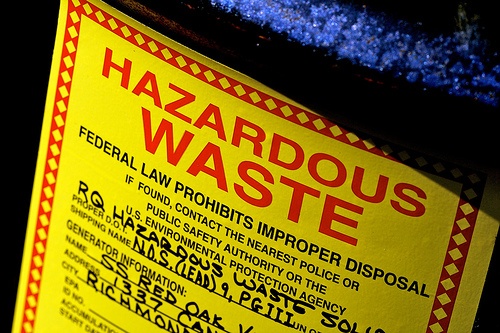The Environmental Protection Agency (EPA) applies its authority under the Resource Conservation and Recovery Act (RCRA) to set national requirements for containers – such as drums – that may be contaminated after use to accumulate hazardous chemicals and wastes. These rules include the “empty container rule” first promulgated in 1980. On August 11, 2023 EPA published in the Federal Register a “Used Drum Management and Reconditioning Advance Notice of Proposed Rulemaking” (ANPRM), setting forth the agency’s thinking about existing container management requirements and possible enhancements and regulatory and non-regulatory alternatives to its existing approaches. The rest of this note summarizes EPA’s ruminations, which may lead to a formal rulemaking.
Read MoreAudit, Compliance and Risk Blog
EPA to reconsider management of containers that held hazardous waste
Posted by Jon Elliott on Tue, Aug 22, 2023
Tags: EPA, RCRA, Hazardous Waste
Mexico adopts workplace safety rules covering teleworkers
Posted by Jon Elliott on Wed, Aug 09, 2023
On June 8, Mexico’s Ministry of Labor and Social Welfare (Secretaría del Trabajo y Previsión Social (STPS)) published Official Mexican Standard (Norma Oficial Mexicana (NOM)) NOM-037-STPS-2023 Telework-Safety and Health Conditions at Work (“NOM-037” or "Standard"), which will take effect on December 5. The new Standard will require employers to take specific measures to protect workers who spend at least 40% of their worktime operating in what the Standard calls the “teleworking modality.” The remainder of this note summarizes these new requirements.
Read MoreTags: workplace safety, STPS, Mexico
This summer is again bringing record-breaking heat to parts of North America. Outdoor work in the summer sun can lead to heat illness, as can indoor work in spaces that aren’t sufficiently insulated or cooled. Since 2008, Washington state has required employer actions to protect employees from extreme heat during summer months, through rules administered by the Department of Labor & Industries’ (L&I’s) Division of Occupational Safety and Health (I discussed the pre-2023 rules HERE). Effective July 17, 2023, L&I has updated its Outdoor Heat Exposures rules, revising and expanding the requirements and making them applicable year-round. The remainder of this note summarizes the changing requirements.
Read MoreTags: Protecting employees, Heat, Be Heat Smart, heat illness, Labor & Industries
OSHA revises Injury and Illness reporting requirements for some large employers
Posted by Jon Elliott on Tue, Aug 01, 2023
The Occupational Safety and Health Administration (OSHA) requires most employers with 10 or more employees at an “establishment” to prepare and maintain records of occupational injuries and illnesses (I&I) as they occur (I&I Logs). OSHA also requires employers to post an annual I&I Summary in each workplace “establishment” by February 1, summarizing that workplace’s I&Is during the previous calendar year. In addition, OSHA requires some employers to submit some of this I&I information electronically to the agency. (I wrote about the initial electronic reporting requirements HERE). On July 21 OSHA updated and revised these electronic reporting requirements (finalizing a proposal I wrote about HERE). The remainder of this note summarizes these changes.
Read MoreTags: OSHA, Protecting employees, workplace safety, Injury, Illness
EPA adds Diisononyl Phthalate Category to Toxics Release Inventory chemical list
Posted by Jon Elliott on Mon, Jul 24, 2023
Effective September 12, 2023, the US Environmental Protection Agency (EPA) has added a new chemical category to its Toxic Release Inventory (TRI) program - Diisononyl Phthalates (DINP). EPA administers TRI as one of the distinct [programs created by the Emergency Planning and Community Right-To-Know Act of 1986 (EPCRA, also referred to as SARA Title III). This is the latest step in EPA’s review and updating of TRI, underway since President Biden assumed office. (I’ve discussed TRI several times, most recently HERE). The rest of this note discusses this latest change, which will require TRI reporting by subject facilities beginning with 2024 data.
Canada identifies possible provisions for a Federal Plastics Registry
Posted by Jon Elliott on Thu, Jul 20, 2023
Environment and Climate Change Canada (ECCC) is developing a Federal Plastics Registry, in support of the government’s goal of zero plastic waste by 2030. The proposed Registry will create a consistent national framework of reporting requirements. On April 23, 2023, ECCC published a Technical Paper with “technical details and reporting requirements” for the Registry, reflecting several years of development –a discussion paper published in October 2020, a “What We Heard” summary of comments received on that paper, a Consultation Paper published in July 2022, and comments received on that document. ECCC intends to formally propose requirements for the Registry by the end of 2023, and to require reporting beginning in 2025.
Read MoreTags: Environmental, Environment, pollutants, plastics, ECCC
EPA clarifies management requirements for waste lithium-ion batteries
Posted by Jon Elliott on Tue, Jul 18, 2023
On May 24, 2023, the Environmental Protection Agency (EPA) released a memo (“Lithium Battery Recycling Regulatory Status and Frequently Asked Questions”) clarifying regulatory requirements for spent lithium-ion batteries, under the Resource Conservation and Recovery Act (RCRA). EPA’s memo acknowledges that lithium-ion batteries power our electronics, lawnmowers, e-scooters, electric bicycles, and rapidly increasing numbers of electric cars, so numbers of spent batteries are also growing rapidly. In this memo, EPA evaluates RCRA’s applicability to lithium-ion batteries, particularly:
- Universal waste handling provisions
- Hazardous waste recycling provisions
- Other RCRA requirements
Based on its analysis, EPA offers clarification that most waste lithium-ion batteries are “likely” hazardous waste, which can be managed under universal waste handling standards until they reach a destination facility for recycling or discard. The rest of this note summarizes information in EPA’s memo.
Read MoreTags: EPA, RCRA, Hazardous Waste
EPA proposes to update and expand mandatory greenhouse gas emission reporting requirements
Posted by Jon Elliott on Fri, Jul 14, 2023
For over a decade, the US Environmental Protection Agency (EPA) has required thousands of facilities and organizations to report annual emissions of greenhouse gases (GHGs), in what it refers to as its Greenhouse Gas Reporting Program (GHGRP) (40 CFR part 98). On May 22, 2023, EPA published an extensive set of proposals to update and expand existing requirements. These proposals supplement and supersede proposals published in June 2022 but not acted on by the agency. The remainder of this note summarizes these proposals, focusing not on the many technical revisions to existing requirements but on proposals to target additional activities with reporting requirements. (I’ve written about EPA’s mandatory GHG reporting program several times, including HERE).
Read MoreTags: Environmental, EPA, Greenhouse Gas, Environment
Canada ratifies international workplace violence prevention treaty and prepares to meet requirements
Posted by Jon Elliott on Fri, Jul 07, 2023
Canada has ratified International Labour Organization (ILO) Convention 190, the “Violence and Harassment Convention, 2019” (also referred to as C190). Ratification was made on January 30, 2023, to become effective January 30, 2024. Canada will consider ILO’s “Recommendation 206,” which provides guidelines on how to apply C190, accounting for complementary roles by governments, workers and employers, and their respective organizations. Readers should note that Canada was intimately involved in the development of C190, proving the chair of the ILO Standard-Setting Committee on Violence and Harassment in the World of Work at the 2018 and the 2019 International Labour Conference.
Read MoreTags: Workplace violence, workplace safety, Canada, ILO, C190
OSHA advisory panel addresses workplace violence prevention in health care
Posted by Jon Elliott on Tue, Jul 04, 2023
Although the U.S. Occupational Safety and Health Administration (OSHA) has not issued any formal regulations requiring employers to address workplace violence, OSHA’s attention to workplace violence prevention (WPV) have grown steadily over time. As an example, OSHA recently convened a Small Business Advocacy Review (SBAR) Panel to address “Prevention of Workplace Violence in Healthcare and Social Assistance sectors.” In May 2023, the Panel issued its final report, outlining steps OSHA should consider next. This review returned to an agency Request for Information posted in the Federal Register in December 2016, just before President Trump assumed office. The remainder of this note discusses the Panel’s recent findings and recommendations.
Read More









